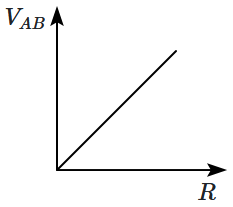The current passing through a certain device doubles when the temperature rises by \(10^{\circ}\text{C}\), in the temperature range from \(0^{\circ}\text{C}\) to \(500^{\circ}\text{C}\). This effect is used to measure the temperature of a sample. The current is measured to be \(5~\text{mA}\) at \(15^{\circ}\text{C}\) and then the next measurement shows a current of \(50~\text{mA}\). The temperature of the new measurement is nearly: (take \(\text{log}_{10}2 \simeq 0.3\), if required)
1. \(150^{\circ}\text{C}\)
2. \(50^{\circ}\text{C}\)
3. \(450^{\circ}\text{C}\)
4. \(25^{\circ}\text{C}\)

To unlock all the explanations of this course, you need to be enrolled.

To unlock all the explanations of this course, you need to be enrolled.

| 1. | \(1.5~\text{V}\) | 2. | \(-1.5~\text{V}\) |
| 3. | \(1.2~\text{V}\) | 4. | \(-1.2~\text{V}\) |

To unlock all the explanations of this course, you need to be enrolled.

To unlock all the explanations of this course, you need to be enrolled.

| 1. | equals \(400~\Omega.\) |
| 2. | equals \(200~\Omega.\) |
| 3. | can have any value less than \(400~\Omega.\) |
| 4. | cannot be determined from the given information. |

To unlock all the explanations of this course, you need to be enrolled.

To unlock all the explanations of this course, you need to be enrolled.

| 1. | \(V=2\) volts, positive at \(A.\) |
| 2. | \(V=2\) volts, negative at \(A.\) |
| 3. | \(V=6\) volts, positive at \(A.\) |
| 4. | \(V=6\) volts, negative at \(A.\) |

To unlock all the explanations of this course, you need to be enrolled.

To unlock all the explanations of this course, you need to be enrolled.

| 1. | \(4~\Omega\) | 2. | \(2~\Omega\) |
| 3. | \(\dfrac43~\Omega\) | 4. | \(\dfrac{10}3~\Omega\) |

To unlock all the explanations of this course, you need to be enrolled.

To unlock all the explanations of this course, you need to be enrolled.

| 1. |  |
2. |  |
| 3. |  |
4. |  |

To unlock all the explanations of this course, you need to be enrolled.

To unlock all the explanations of this course, you need to be enrolled.

| 1. | \(1~\text A\) | 2. | \(0.5~\text A\) |
| 3. | \(2.5~\text A\) | 4. | \(3~\text A\) |

To unlock all the explanations of this course, you need to be enrolled.

To unlock all the explanations of this course, you need to be enrolled.
1. \(2~\Omega\)
2. \(4~\Omega\)
3. \(6~\Omega\)
4. \(1.6~\Omega\)

To unlock all the explanations of this course, you need to be enrolled.

To unlock all the explanations of this course, you need to be enrolled.
1. \(1\)
2. \(\dfrac12\)
3. \(\dfrac21\)
4. \(\sqrt2\)

To unlock all the explanations of this course, you need to be enrolled.

To unlock all the explanations of this course, you need to be enrolled.

1. \(2 ~\Omega\)
2. \(3.2 ~\Omega\)
3. \(4 ~\Omega\)
4. \(6.4 ~\Omega\)

To unlock all the explanations of this course, you need to be enrolled.

To unlock all the explanations of this course, you need to be enrolled.






